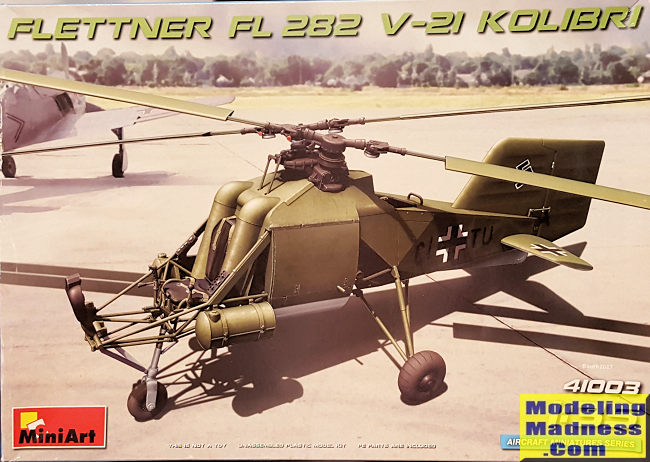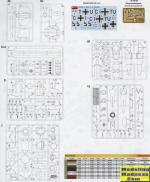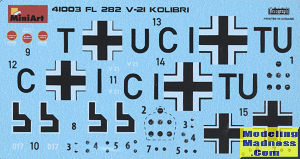
| KIT #: | 41003 |
| PRICE: | $20.00 from a vendor |
| DECALS: | One option |
| REVIEWER: | Scott Van Aken |
| NOTES: | 2018 release |

| HISTORY |
The Fl 282 Kolibri was an improved version of the Flettner Fl 265 announced in July 1940, which pioneered the same intermeshing rotor configuration that the Kolibri used. It had a 7.7 litre displacement, seven-cylinder Siemens-Halske Sh 14 radial engine of 150-160 hp mounted in the center of the fuselage, with a transmission mounted on the front of the engine from which a drive shaft ran to an upper gearbox, which then split the power to a pair of opposite-rotation drive shafts to turn the rotors.
The Sh 14 engine was a venerable, tried-and-true design with low specific power output and low power/weight ratio (20.28hp/L, 0.54hp/lb, which could (anecdotally) run for up to 400 hours without major servicing, as opposed to the more powerful 27 litre displacement, nine-cylinder BMW/Bramo Fafnir 750 hp radial engine powering the larger Focke Achgelis Fa 223 helicopter, whose higher output (27.78hp/L, 0.62hp/lb), more modern design required moderate maintenance as often as every 25 hours (such as changing spark plus, etc, well within the norm for modern radial engines of that era). While such a heavy and low-powered engine would work well in a very small craft like the Fi 282, to try and scale it up and use an engine of equivalent power/weight ratio in the 700-1000hp class would result in a massive and heavy engine leaving little excess capacity for cargo or passengers. 750hp was the lowest rating that the Fafnir was available in - indeed, it was a low-power, low maintenance design compared with many other engines of this era. The Fl 282's fuselage was constructed from steel tube covered with doped fabric, and it was fitted with a fixed tricycle undercarriage.
The German Navy was impressed with the Kolibri and wanted to evaluate it for submarine spotting duties, ordering an initial 15 examples, to be followed by 30 production models. Flight testing of the first two prototypes was carried out through 1941, including repeated takeoffs and landings from a pad mounted on the German cruiser Köln.
The first two "A" series prototypes had enclosed cockpits; all subsequent examples had open cockpits and were designated "B" series. In case of an engine failure, the switch from helicopter to autorotation was automatic. The aircraft was used operationally and assigned to Transportstaffel 40 along with other German helicopters.
| THE KIT |
 MiniArt
has chosen to align this kit with the armor rather than the aircraft folks by
producing this kit in 1/35 scale. I don't know how you feel about that, but to
me it makes little difference as there won't really be anything on the airplane
builder's shelf with which to compare it.
MiniArt
has chosen to align this kit with the armor rather than the aircraft folks by
producing this kit in 1/35 scale. I don't know how you feel about that, but to
me it makes little difference as there won't really be anything on the airplane
builder's shelf with which to compare it.
Molding is very much up to modern specs as you'd expect from MiniArt. There is a significant amount of detail in this and that is because so much is exposed. The lattice framework consumes much of the build as does the very detailed engine, gearbox and rotor assembly. Even those fuselage parts that duplicate the fabric covered sections have framework detail on the 'inside'.
There are areas that will require some drilling and
trimming to properly build this, which points to possibly other variants being
kitted. As this is the B model, there is a rudimentary rear facing seat aft of
the engine, which had to be uncomfortable. Photo etch is held to a minimum and
consists of the pilot's harness, some interior bulkhead formers and a few other
small items. There is no belt for the rear passenger. There are decals for the
cockpit instrument panels which is nice. The finished model will be a tail
sitter and finding places to put any sort of weight will be a challenge. I would
suggest at least filling the two side fuel tanks with weight as a start.
Everything else forward of the main gear is
 exposed so
that would be about it.
exposed so
that would be about it.
Instructions are excellent and provide multiple paint references. The lone markings option is in RLM 71 over RLM 65 so painting will be pretty straight forward. It appears that the rotor blades are 71 upper and black on the underside. Decals are nicely done and should work well. As usual, the swastika is in pieces.
| CONCLUSIONS |
Like all kits, the complete truth is in the building. However, this one looks very nice in the box (which is twice as big as the sprues it holds). The real telling will be on how all that framework goes together. If it is well engineered, it will make the kit a pleasure. Not for beginners due to all the pieces.
| REFERENCES |
https://en.wikipedia.org/wiki/Flettner_Fl_282
December 2019 Copyright
ModelingMadness.com. All rights reserved. If you would like your product reviewed fairly and fairly quickly, please
contact
the editor or see other details in the
Note to
Contributors.
Back to the Main Page
Back to the Review
Index Page
Back to the Previews Index Page